




OUR BEST EVER OFFER - SAVE £100/$100
JOIN THE WORLD'S LEADING PROFESSIONAL DEVELOPMENT PROGRAMME
- 12 months membership of Elite Soccer
- Print copy of Elite Player & Coach Development
- Print copy of The Training Ground
The confrontation line
This exclusive session is about counter-attacking in a 4-3-3 formation, with the use of a ‘confrontation line’. This virtual line gives players a unique positioning point to defend up to before releasing a counter-attack.
| Area | Full pitch |
| Equipment | Ball, goals |
| No. of Players | 22 |
| Session Time | 20-30mins |
This session is about counter-attacking in a 4-3-3 formation, with the use of a ‘confrontation line’. This virtual line gives players a unique positioning point to defend up to before releasing a counter-attack. The line moves depending on the opposition and how quickly they progress with the ball, but is always around the halfway line.
The practice enables attack-minded players to learn their responsibilities when both in and out of possession.
What do I get the players to do?
In a two-way 11v11 game, blues begin as the attacking team, with whites the counter-attackers.
When blues play out from the back, whites’ first instinct must be to press opponents and attempt to win the ball. If, however, an opponent is too far away so that a white is unable to directly and quickly affect his decision-making, then all whites must retreat back towards the confrontation line (1a), which is to be indicated by the coach.
1a
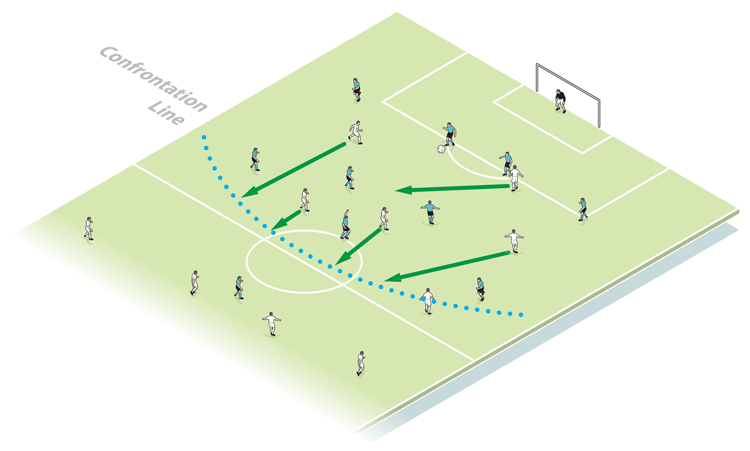
Retreating to the confrontation line will encourage blues to advance. When play approaches the line, the defending team must move in to win the ball (1b). If they can do that, the compact nature of their frontline now makes it possible for quick counter-attacks to be made behind the blues’ defence, either with a direct pass (1c) or varied passing combinations (1d).
1b
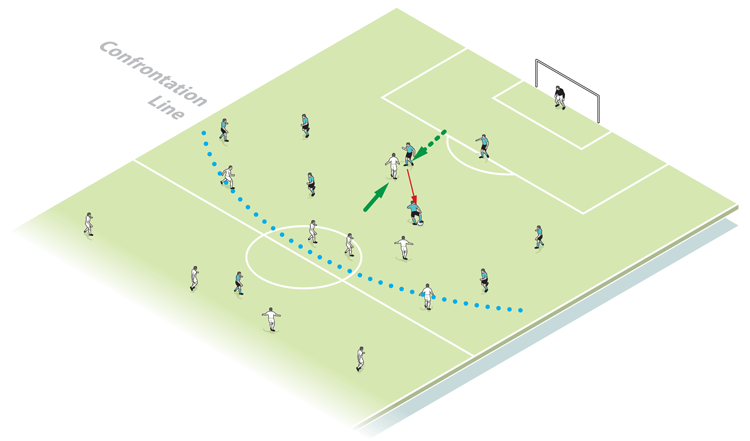
1c
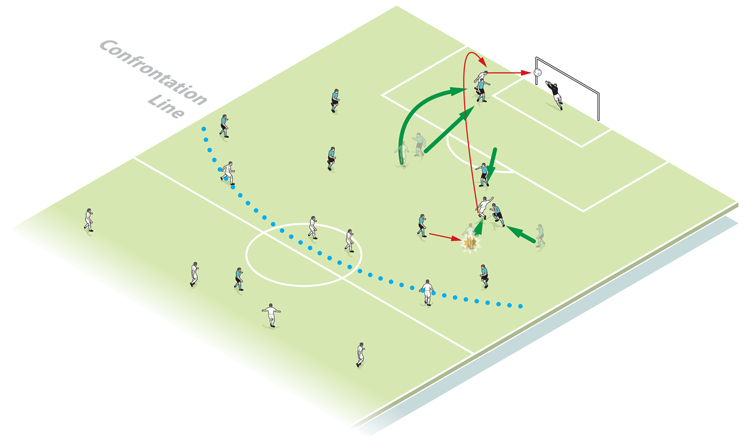
1d
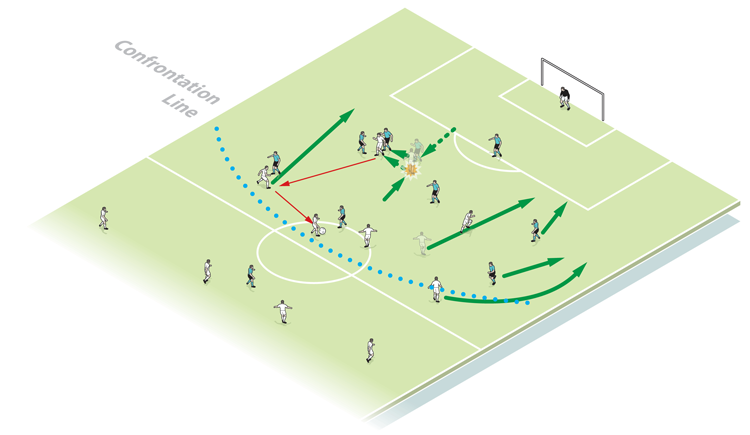
The roles and responsibilities of all 11 whites are therefore very important when the team is out of possession, and good communication is essential.
How do I progress the session?
To ensure that teams don’t sit deep we add a restraining line, which represents the furthest point that defenders can drop to. This compression of play in match practice allows a free flow of counter-attacking scenarios to develop at both ends (2). We’ll also pause play to highlight developing situations.
2
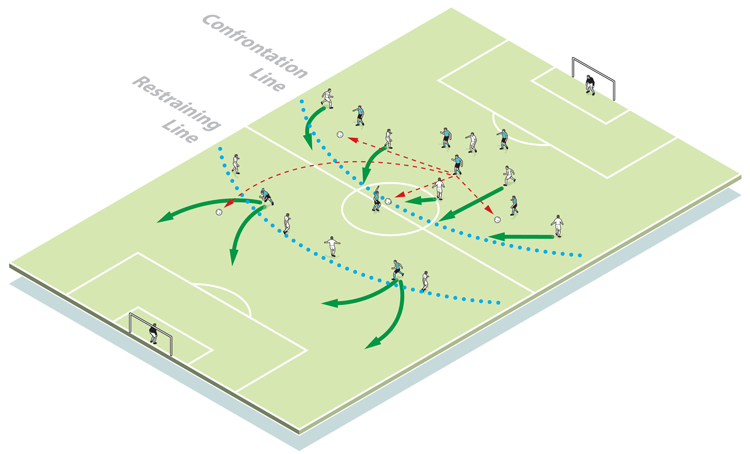
What are the key things to look for technically/tactically?
Players who press must realise when to approach and when to drop back, quickly communicating this decision to team mates. When preparing to counter, team mates must be similarly clear about the areas that are to be attacked (3).
3
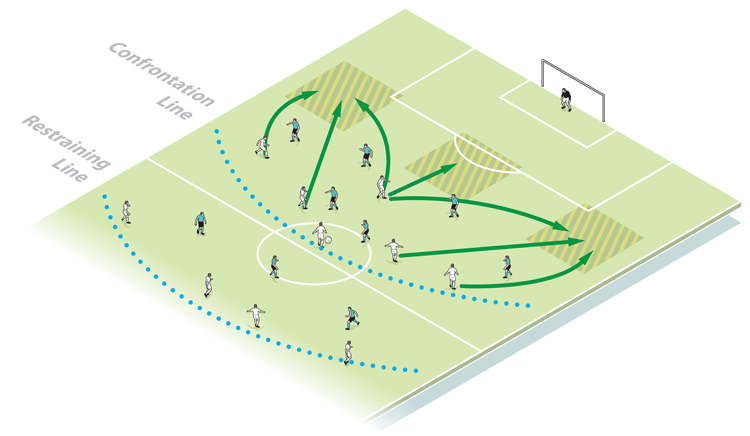
Remember too that counter-attacking teams must themselves be aware of being exposed, so team mates must cover forward breaks. For example, if the full-back is counter-attacking, the centre-backs and opposite full-back must slide across, with a midfielder dropping into the gap as extra support.
Related Files
Editor's Picks
Attacking transitions
Deep runs in the final third
Using the goalkeeper in build-up play
Intensive boxes drill with goals
Penetrating the final third
Creating and finishing
My philosophy
Pressing initiation
Compact team movement
Coaches' Testimonials

Alan Pardew

Arsène Wenger

Brendan Rodgers

Carlos Carvalhal

José Mourinho

Jürgen Klopp

Pep Guardiola

Roy Hodgson

Sir Alex Ferguson

Steven Gerrard
Coaches' Testimonials

Gerald Kearney, Downtown Las Vegas Soccer Club

Paul Butler, Florida, USA

Rick Shields, Springboro, USA

Tony Green, Pierrefonds Titans, Quebec, Canada
Join the world's leading coaches and managers and discover for yourself one of the best kept secrets in coaching. No other training tool on the planet is written or read by the calibre of names you’ll find in Elite Soccer.
In a recent survey 92% of subscribers said Elite Soccer makes them more confident, 89% said it makes them a more effective coach and 91% said it makes them more inspired.
Get Monthly Inspiration
All the latest techniques and approaches
Since 2010 Elite Soccer has given subscribers exclusive insight into the training ground practices of the world’s best coaches. Published in partnership with the League Managers Association we have unparalleled access to the leading lights in the English leagues, as well as a host of international managers.
Elite Soccer exclusively features sessions written by the coaches themselves. There are no observed sessions and no sessions “in the style of”, just first-hand advice delivered direct to you from the coach.







